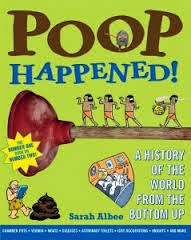Summary: "The number one book on number two." It's a great phrase to summarize a surprisingly great book about the history of the world and the way it's dealt with its...well, poop. Albee tells how earlier civilizations got rid of their feces and how their ignorance of the diseases brought illnesses and death. So many cultures handled their waste by dumping it in the nearest river and then gathering that same water to drink from. It's unfortunate that this cycle repeats itself throughout history with the same fatal results. Albee combines history and trivial facts with humor. Reading about Egyptian, Roman, Greek, and English history in this light was very enlightening and makes the reader appreciative of the current plumbing that we have today. What Albee also points out is that many contemporary third world societies live under the same conditions of the past, suffering from the same diseases and deaths of long ago. Albee hopes that by writing this book she'll bring attention to the plight of the less fortunate in our world today.
Reference: Albee, S. (2010). Poop happened!: A history of the world from the bottom up. New York, NY. Walker & Company.
Impressions: Just the title alone grabs attention. I found it to be humorous and the book lived up to my expectations. Yes, there were some pictures that lacked description with explanation of the image mentioned later on, but overall the illustrations and photos worked well together. Despite its subject matter, the writing wasn't dumb downed and would often provide definition of terms as a side note to the main topic to help the reader learn and understand. There was a good deal of information that teaches and opens up the readers minds. This is one of the books I have on my ever-growing check-out list from Amazon, so that I can add it to my personal collection.
Professional Review: Ever wondered what early civilization used for toilet paper? How did Victorian ladies wearing huge hoop skirts manage to "go" when they could not even sit down? Did a guy named Crapper really invent the toilet? Get the straight poop on these and many other moving questions while exploring an age-old problem: what to do when nature calls. In addition to the fun facts described as "Too Much Information" or "TMI," "Hygiene Heroes" identify people (Thomas Crapper was one of them) responsible for everything from the critical understanding of why "poop matters" to the engineering marvel of today's modern plumbing and waste disposal systems. Albee does a very clever job of tying social and historical events into what might otherwise be considered a somewhat off-color topic. Indeed the author convincingly makes the case that over the ages, fecal matter was a constant driver of both human suffering and innovation. The interesting captions and eye-catching illustrations enthusiastically lead the reader on a journey through time and examine not only some of the aforementioned logistical and often humorous issues, but also the very serious outbreaks of disease that, even today, occur as a result of ignorance, improper hygiene, social class distinction, and non-disposal of human and animal excrement. There is a curiosity factor that cannot be denied when looking at the cover of this book. As a result, children, teens, and adults will undoubtedly learn more about the potty than they ever imagined possible.
Brink-Drescher, J. (2014). [Review for Poop Happened!: A history of the world from the bottom up]. VOYAMagazine.com. Retrieved from http://www.barnesandnoble.com/w/poop-happened-sarah-albee/1111672539?ean=9780802720771.
Library Use: The information from Poop Happened! could be shared in any World History class to the delight of all students both in elementary and secondary. Our school also has Environmental Science class that I think could definitely benefit from learning what Albee writes. It could also be shared on Earth Day. Whatever the situation, I think children will be both amused and disgusted by the world's dealing with its waste. Plus, it would help bring light into the plights of so many who are suffering even today.

Comments
Post a Comment